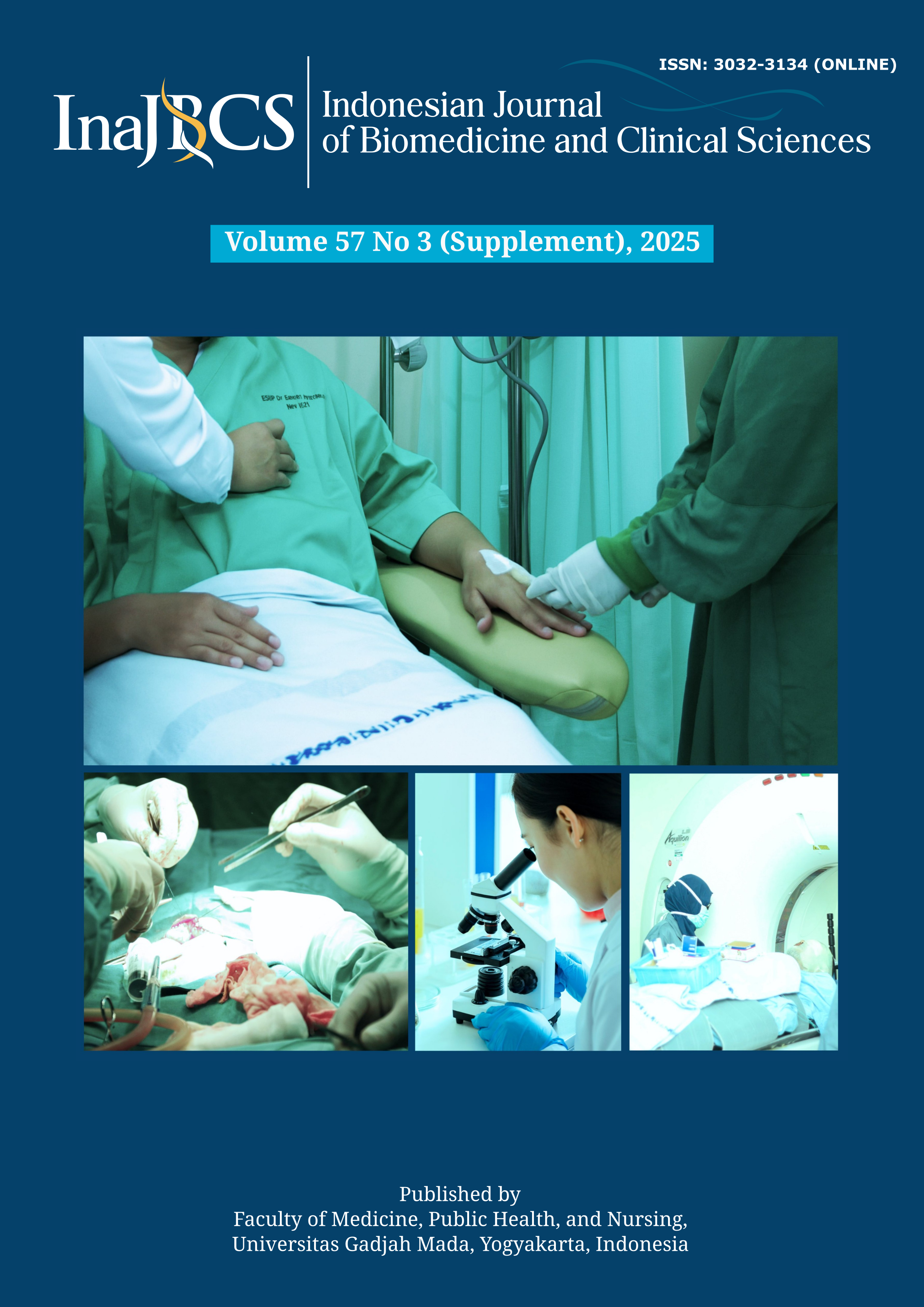Chronic eosinophilic leukemia in a 33-year-old male
Abstract
Chronic Eosinophilic Leukemia (CEL) is a rare hematologic malignancy characterized by persistent clonal eosinophils’ proliferation with an incidence of less than 1 in 100,000 individuals. Accurate diagnosis requires exclusion of secondary hypereosinophilia and demonstration of clonality, making it a diagnostic challenge for clinicians. We present a case of a 33-year-old Indonesian male who developed persistent generalized pruritus accompanied by constitutional symptoms. Physical examination revealed pallor, splenomegaly (S6), and lymphadenopathy. Laboratory findings showed severe anemia (hemoglobin 8.4 g/dL) and marked hypereosinophilia with eosinophils comprising 52% of total leukocytes (absolute count 5,221/mm³, normal <500/mm³). Serum IgE levels remained normal (15.7 IU/mL). Bone marrow aspiration demonstrated significant proliferation of the eosinophil lineage. Bone marrow biopsy revealed hypercellular marrow with morphologically abnormal eosinophils showing sparse granulation and nuclear hyposegmentation, accompanied by grade 3 myelofibrosis and reduced megakaryocytes. BCR-ABL fusion gene testing was negative, excluding chronic myeloid leukemia. JAK2V617F mutation was absent. Stool examination ruled out parasitic infections. Flow cytometry showed hypereosinophilia (79%) without aberrant immunophenotypic markers. Due to laboratory limitations in Indonesia, PDGFRA, PDGFRB, and FGFR1 mutation analyses could not be performed.The patient was initially diagnosed with hypereosinophilic syndrome and treated with supportive care including packed red cell transfusions for anemia, hydroxyurea as cytoreductive therapy, and hematopoietic support with folic acid and B-complex vitamins. However, hypereosinophilia persisted despite initial treatment. Imatinib mesylate, a tyrosine kinase inhibitor, was initiated as targeted therapy. The patient demonstrated an excellent therapeutic response with reduction of eosinophil percentage from 52% to 4% and significant improvement in organomegaly; spleen size decreasing from S6 to S3. The excellent response to imatinib suggests possible underlying kinase-activating mutations, despite negative BCR-ABL and JAK2V617F testing. This case highlights the diagnostic complexity of CEL in resource-limited settings and demonstrates the potential efficacy of empirical imatinib therapy. The clinical and hematologic improvement underscores the importance of considering targeted therapy in CEL patients, particularly when conventional cytoreductive agents fail. Further molecular studies, would be valuable for confirming the diagnosis and optimizing treatment strategies in similar cases.
Leukemia Eosinofilik Kronik (LEK) adalah keganasan hematologis yang langka yang ditandai oleh proliferasi klonal eosinofil secara persisten, dengan insiden kurang dari 1 dalam 100.000 individu. Diagnosis yang akurat memerlukan pengecualian terhadap hipereosinofilia sekunder dan pembuktian adanya klonalitas, sehingga menjadi tantangan diagnostik bagi klinisi. Kami melaporkan kasus seorang pria Indonesia berusia 33 tahun yang mengalami pruritus generalisata persisten disertai gejala konstitusional. Pemeriksaan fisik menunjukkan pucat, splenomegali (S6), dan limfadenopati. Pemeriksaan laboratorium menunjukkan anemia berat (hemoglobin 8,4 g/dL) dan hipereosinofilia mencolok dengan eosinofil mencapai 52% dari total leukosit (jumlah absolut 5.221/mm³, normal <500/mm³). Kadar IgE serum tetap normal (15,7 IU/mL). Aspirasi sumsum tulang menunjukkan proliferasi signifikan dari garis keturunan eosinofil, sementara biopsi sumsum tulang memperlihatkan sumsum hiperseluler dengan eosinofil yang morfologinya abnormal, memiliki granula yang jarang dan segmentasi inti yang buruk, disertai mielofibrosis derajat 3 dan penurunan jumlah megakariosit. Pemeriksaan gen fusi BCR-ABL menunjukkan hasil negatif, sehingga leukemia mieloid kronik dapat disingkirkan. Mutasi JAK2V617F juga tidak ditemukan. Pemeriksaan tinja menyingkirkan infeksi parasit. Sitometri alir menunjukkan hipereosinofilia ekstrem (79%) tanpa penanda imunofenotipik abnormal. Karena keterbatasan laboratorium di Indonesia, analisis mutasi PDGFRA, PDGFRB, dan FGFR1 tidak dapat dilakukan. Pasien awalnya didiagnosis dengan sindrom hipereosinofilik dan diberikan perawatan suportif, termasuk transfusi sel darah merah terpakai untuk mengatasi anemia, hidroksiurea (1500 mg per hari) sebagai terapi sitoreduktif, serta dukungan hematopoietik berupa asam folat dan vitamin B kompleks. Namun, hipereosinofilia tetap bertahan meskipun sudah diberikan terapi awal. Selanjutnya, imatinib mesylate (400 mg per hari), sebuah inhibitor tirosin kinase, diberikan sebagai terapi target. Pasien menunjukkan respons terapeutik yang sangat baik dengan penurunan dramatis kadar eosinofil dari 52% menjadi 4%, serta perbaikan signifikan pada organomegali, dengan ukuran limpa menyusut dari S6 menjadi S3. Respons yang sangat baik terhadap imatinib ini menunjukkan kemungkinan adanya mutasi aktivasi kinase yang mendasari, meskipun hasil pemeriksaan BCR-ABL dan JAK2V617F negatif. Kasus ini menyoroti kompleksitas diagnostik LEK di daerah dengan sumber daya terbatas dan menunjukkan potensi efektivitas terapi imatinib secara empiris, bahkan tanpa karakterisasi molekuler yang lengkap. Perbaikan klinis dan hematologis yang dramatis ini menegaskan pentingnya mempertimbangkan terapi target pada pasien LEK, terutama ketika agen sitoreduktif konvensional gagal. Studi molekuler lebih lanjut, bila tersedia, akan sangat berguna untuk mengonfirmasi diagnosis dan mengoptimalkan strategi pengobatan pada kasus serupa.






